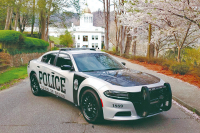Journey to the 21st century: Two-room school transforms to major regional university
 By Randall Holcombe • WCU
By Randall Holcombe • WCU
The little school that was the forerunner of Western Carolina University was called Cullowhee Academy. Its location is marked by a stone memorial, erected in 1934, that sits in a garden area between the university’s steam plant and Breese Gymnasium. The memorial honors Robert Lee Madison, who was 22 when he taught his first class of 18 students at the academy on Aug. 5, 1889.
The university that has grown up around Madison’s stone memorial is a far cry from that little school. Grand buildings and a rolling campus have settled into Cullowhee’s landscape over the past 125 years. WCU’s influence, however, now extends even beyond its campus, helping to shape Western North Carolina.
The “Cullowhee idea”
In July 1889, a young Madison was preparing to leave Western North Carolina, where he served as the editor of the Tuckaseige Democrat newspaper and principal of the Jackson Academy in Sylva. He had been offered a principal’s position in Raleigh.
Madison was working on his acceptance letter for the Raleigh position when Lewis J. Smith, a prominent citizen from Cullowhee Valley, appeared at his doorstep. A teacher at the Cullowhee Academy had recently resigned to enter to ministry, and Smith pitched the job to Madison.
Related Items
Madison later wrote about those events for the Asheville Citizen newspaper in 1938: “That hot August afternoon, following my acceptance of the invitation to visit Cullowhee, found me seated by the side of State Senator Lewis J. Smith in a topless buggy drawn by a sturdy mule en route to the ‘Valley of the white Lilies.’” Once in Cullowhee, the prospective teacher met with 40 to 50 citizens and presented a speech on education.
Hired for a salary of $40 per month by the educationally minded citizens, Madison had found a permanent home for the vision he held of opening a school to prepare teachers to serve in rural areas. In later years, he called it “the Cullowhee Idea.”
As Madison described it, his academy “consisted of one-fourth of an acre and a frame structure in the shape of an L, intended for a two-room building but having no partitions, fixed or moveable. The house was unfinished, unpainted and unfurnished except for a few long, heavy benches and a blackboard. The value of the lot and the improvement was less than $800.” As the school began a 10-month session under Madison’s leadership, 12 of the 18 pupils attending were the children of board members. But during the succeeding months, more than 100 students ranging in age from 6 years old to the mid-20s enrolled, with new students coming in from surrounding communities and counties. By the end of the year, Madison had hired his sister Marguerite to teach the younger children.
With enrollment growing, Madison began his second year in Cullowhee by gaining permission to hold classes in the nearby Baptist church, and a new music and art building was added to the site beside the schoolhouse.
The academy had no boarding facilities in its early years. Students who needed a place to live were taken in as boarders in local homes, and some rented small cabins or shacks. Madison wrote about the environment in which the little school existed: “The Cullowhee valley and adjacent territory were at that time sparsely settled; but much of the land was fertile and the owners, most of whom lived in good homes, were intelligent, progressive and public spirited.”
In 1891, Madison and his board requested a charter from the N.C General Assembly, and the institution was renamed Cullowhee High School. The school had nine trustees, most of whom had been involved since its founding, and Madison called them the “Noble Nine.” Two years later, he wrote to a local state representative to encourage funding for a statewide system of teacher training schools. That idea was rejected, but Cullowhee High School did receive a $1,500 appropriation to support a “normal” department — a department for training teachers. Teacher training began in Cullowhee, and by 1897 enrollment had grown to 234 students.
The 20th Century
In 1901, the school at Cullowhee received its first capital improvement money from the state – $5,000 for construction of a building to house its normal department. Another $2,000 was later appropriated for the project, but local contributions of money, materials and labor were required to make the Madison Building a reality. Later known as “Old Madison,” the structure was completed in 1904. It was erected up the hill behind the original schoolhouse on three acres of land donated by David Rogers. The three-story structure represented a large expansion of facilities for the little school, and Old Madison remained in use until it was replaced by the new Madison Hall in 1939.
By 1905, Cullowhee High School had become a full-fledged public institution and its name had changed to Cullowhee Normal and Industrial School, with the campus consisting of three buildings and 4.1 aces. As enrollment grew, the state legislature approved $7,000 in funding for the school’s first residence hall, Davies Home. Built at the top of the hill above Old Madison, it was torn down and replaced by Reynolds Residence Hall in 1953. By 1910, enrollment at CNIS had stagnated and Madison was released from his duties and was replaced by Alonzo C. Reynolds, superintendent of Buncombe County schools.
Not long after Reynolds’ arrival in Cullowhee, a decision was made to construct a new classroom and administration building. Completed in 1913, the Joyner Building was the center of campus life for many years. The school added a two-year college curriculum to its offerings during the Reynolds administration, and after he announced his resignation at the end of the school year in 1920, Madison returned to lead CNIS once again.
In 1923, the high school function of the school at Cullowhee was removed with a new state charter and the institution became Cullowhee State Normal School. Madison resigned that year but remained as an English teacher until 1937. Hiram Hunter was hired as the next president of the institution.
One of the most significant developments for the school at Cullowhee involved no new buildings, but instead was a major land acquisition that provided room for growth in the decades that followed. David Rogers, a prosperous farmer and strong supporter of the school, sold his 60-acre “Town House” farm to the institution in 1924. The tract included 20 acres in pasture and 32 acres of cropland; the rest was woodlands. Funding for the land purchase came from a state appropriation of $438,000 designated for capital improvements and operating expenses. The 1920s also brought the addition of two new residence halls, Moore and Robertson, to the campus.
As the 1920s were coming to a close, Cullowhee State Normal School was converted into a four-year institution granting bachelor’s degrees in education, and under a revised charter was renamed Western Carolina Teachers College. The college marked its 50th anniversary in 1939 with its largest building program so far. The new construction was noteworthy, also, as campus facilities expanded off the historic hill area and onto land that had once been part of the Rogers farm. Facilities were doubled as several federal programs were utilized for construction of a new Madison to replace Old Madison, a student union, Graham Infirmary, McKee Classroom Building, Breese Gymnasium and Hoey Auditorium. The buildings were completed by 1939, just before World War II caused enrollment to tumble as many of the college’s men and women left to take part in the war effort. Enrollment rebounded after the war ended, but the physical campus remained mostly unchanged until the early 1950s.
With enrollment at 610 in 1950, WCTC went through another building boom as the Legislature approved $2 million for new construction. Additions in those years included the Stillwell and Natural Science buildings, Hunter Library, Reid Gymnasium, Killian Building and Reynolds and Buchanan residence halls. After Hunter’s death in 1947, the college was guided at various times over the following two decades by W. Ernest Bird or Paul A. Reid. The institution began offering its first graduate program, a master’s in education, in 1951, and it became Western Carolina College in 1953. By the mid-1950s, enrollment had risen to just over 1,100 students.
The succeeding years would bring a surge in student population, with enrollment topping 4,000 by 1968, a year after the college was elevated to university status. The 1960s was also a period of significant new construction, with additions including Brown Cafeteria, Bird Building, Killian Annex, A.K. Hinds University Center, Dodson Cafeteria and Albright/Benton, Scott, Helder and Leatherwood residence halls.
Western Carolina’s academic programs developed dramatically in the late 1970s and early 1980s, and the transition from a teachers college to a regional university was completed. The 1970s brought the addition of E. J. Whitmire Stadium, Belk Building, Walker and Harrill residence halls and H.F. Robinson Administration Building, along with a new building to house English and music programs.
H. F. “Cotton” Robinson became chancellor in 1974 and held that post for 10 years, and his term of leadership was followed by the administration of Myron L. Coulter, who also served for a decade. Western Carolina became a member of the consolidated University of North Carolina system in 1972, and in 1975 the university’s Cherokee Center was established in Cherokee to connect WCU to the tribal community. Campus additions during the 1980s included the Ramsey Regional Activity Center and the Alumni Tower, which was built by the WCU Alumni Association to mark the university’s 100th anniversary in 1989.
Enrollment at WCU remained mostly in the 6,000s as the university moved through the 1990s, with John W. Bardo beginning his term as chancellor in 1994. During the last 12 years of Bardo’s administration, as WCU entered the 21st century and toughened standards for admission, enrollment surged upward from nearly 6,700 in the year 2000 to more than 7,500 in 2003, and then above 9,000 by 2007.
The Big Boom
On paper, the numbers are staggering. Between 2000 and 2012, new building, renovation and infrastructure projects valued at $327 million were completed, adding more than 1.1 million square feet of new space to WCU. The match that lit the dynamite setting off the transformation of WCU’s campus was the statewide approval of a $3.1 billion higher education bond package in November 2000. The vote cleared the way for nearly $100 million in bond-funded construction projects on the WCU campus.
Chuck Wooten, a 1973 graduate of WCU, had a front-row seat for that building boom as the university’s vice chancellor for administration and finance from 2001 through 2010. Wooten said he came back to WCU in 1980 to work with the business staff and found that “the campus was basically what it was when I left.” The funding that became available as a result of the 2000 bond vote was the “critical component” in the move to update WCU’s campus for the new century, said Wooten, who is now the Jackson County manager.
In addition to the $30 million Bardo Fine and Performing Arts Center, other major new facilities added during the first dozen years of the new century included the $21 million Central Drive Residence Hall, the $21 million Campus Recreation Center, the $18 million Courtyard Dining Hall, the $12 million Village housing complex, the $10 million Norton Road Residence Hall, the $50 million Balsam and Blue Ridge residence hall complex and the $46 million Health and Human Sciences Building. The Stillwell Science Building was renovated at a cost of $26 million.
Another $8 million from the federal government made possible the Center for Applied Technology, and more than $13 million went toward improvements for athletics facilities. Also, $12 million in infrastructure improvements included the relocation of Centennial Drive, a state road that formerly bisected the center of campus where the Central Plaza and fountain are now located.
A Vision for Tomorrow
Endorsed by the Board of Trustees in December 2013, Western Carolina’s new master plan is the result of a 17-month process that included numerous public forums involving members of the campus community and local residents. It is based on enrollment projections that estimate more than 11,000 students studying on the Cullowhee campus by the year 2023 and the need for an additional 486,000 square feet of space to accommodate those students. About 7,800 of WCU’s current enrollment of approximately 10,100 students now live and study in Cullowhee.
The plan focuses on a land-use scheme that emphasizes placing new academic development in the center of campus to maximize the use of existing infrastructure, enhancing programmatic efficiencies and encouraging a pedestrian-oriented community.
While the passing decades have brought profound changes to campus, in recent years the university has reaffirmed its mission to serve the citizens of the Western North Carolina region, not just by offering higher education opportunities but also through the expertise and energy of its faculty, staff and students, who are working with local businesses and organizations to boost quality of life and the region’s economic vitality.
University officials hope to strengthen ties to communities in North Carolina’s far western counties as they also engage in initiatives to serve the fast-growing corridor along Interstate 26 in Buncombe and Henderson counties. This fall, WCU’s undergraduate engineering program will be expanded to the university’s instructional site at Biltmore Park Town Square in south Asheville.
WCU is also focusing its energies outside its campus boundaries. Through initiatives such as distance learning — web-based education — WCU is reaching students across the country and, in the cases of military students currently stationed overseas, around the world.
When the seeds that became WCU were first sown 125 years ago, Robert Lee Madison’s voice and influence went only as far as the ears and minds of his 18 students as he taught them that first year in Cullowhee. And while WCU has grown and evolved over the years, with the voice of the modern university extending around the world, it owes its genesis to Madison’s “Cullowhee idea.”
Editor’s note: This article (edited for space from its original version) appears in the just-published fall edition of The Magazine of Western Carolina University, which pays homage to the university’s 125th anniversary. The magazine can be viewed online at http://magazine.wcu.edu/.









